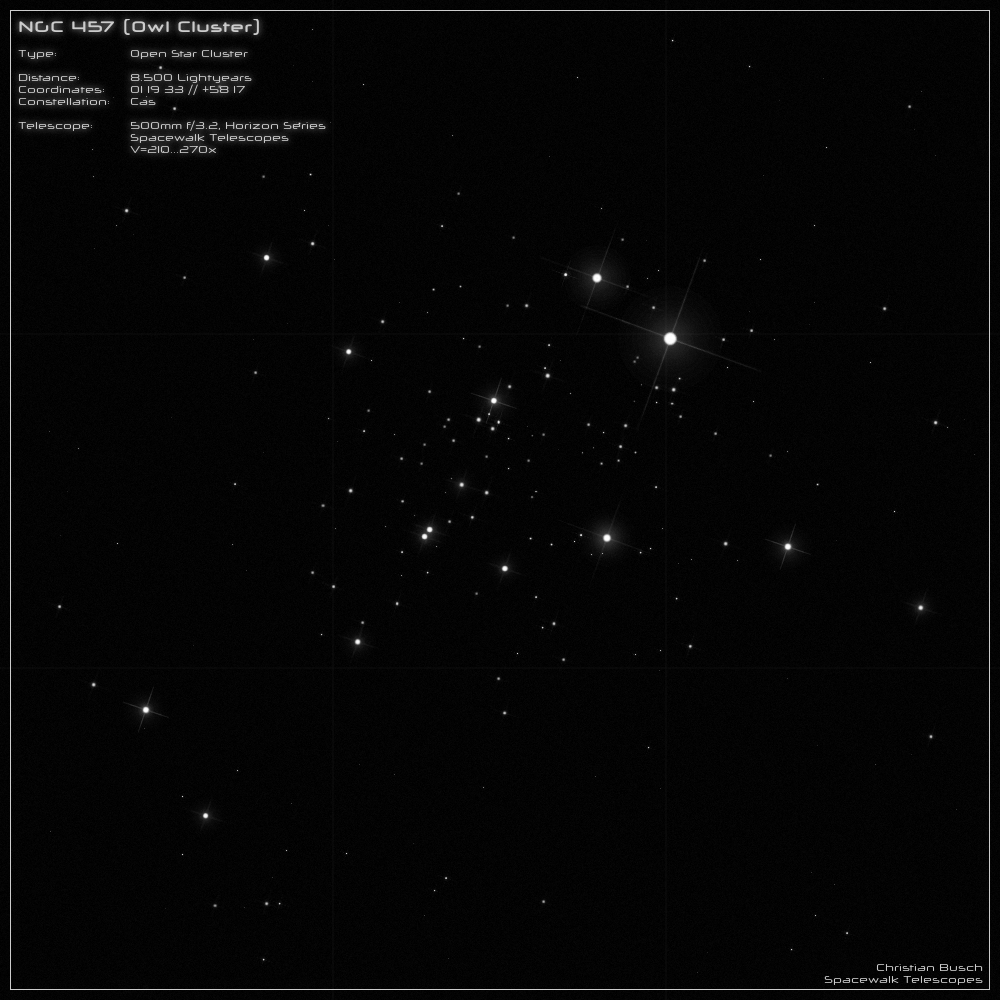NGC 457, Eulen- Sternhaufen
The Owl Cluster is certainly one of the most beautiful open star clusters in the constellation Cassiopeia. With a total visual magnitude of 6.4mag it can be
seen in binoculars and even in a small telescope it reveals its wonderful shape, which has earned it some sonorous names. Among others, two bright stars
at the southeastern end of the cluster have contributed to this, which are seen as eyes by many observers and probably led to the two most famous names
"Owl Cluster" or "E.T Cluster". One finds NGC 457 only 2° south of the 2.6mag bright star "delta Cas".
NGC 457 is located about 8,000 to 9,000 light-years from Earth in the Perseus spiral arm of our Milky Way. With an apparent diameter of 15-20' it appears
in the sky about half the size of the full moon. The true diameter is calculated to 46 lightyears - a really large value for an open star cluster. The age is given
with 21 million years.
More than 200 stars are attributed to the cluster. But for the two brightest stars "phi Cas" and "HD 7902" it is not sure if they are really members of NGC 457.
At least for "phi Cas" it is assumed that it is a foreground star. If we look at the proper motions of the cluster and of "phi Cas", we can't make a sure statement.
Also the distance data based on parallax measurements are afflicted with too large uncertainties. However, since "phi Cas" is a multiple star system with a total
of 5 components, indirect conclusions can be drawn which actually place the star in the foreground of NGC 457 - more precisely in a distance of 4,500 lightyears.
Therefore it would be only half as far away as the star cluster itself. From the apparent magnitude of 5.0mag a luminosity for "phi Cas" of -7.2mag can be calculated,
which corresponds to about 60,000 solar luminosities. Therefore it belongs to the group of "F-supergiants" and would shine as bright as the planet Venus even in a
distance of 100 light-years. A similarly monstrous star is "HD 7902", the second eye of the owl. It is a hot B- giant with a surface temperature of nearly 20,000
Kelvin and a luminosity of 30,000 solar luminosities. For the sake of completeness a third giant star should be mentioned: "BD+57 258", a so called M- supergiant
with a luminosity of 7,500 suns. This red giant star is at the end of its life cycle.
These three stars alone and the physics behind them make NGC 457 an absolutely exciting object.
----------------------------------------------------------------------------------------------------------------------------------------------
But now we want to dedicate ourselves to the observation with the telescope. With 50cm aperture the owl cluster offers a fascinating sight that almost takes your
breath away.
Already at a relatively low magnification of 120x many stars are visible, among them of course the two "eyes" of the owl. These form a very nice color contrast -
while "phi Cas" glows yellowish, "HD 7902" shows a light blue hue. Not far away, "BD+57 258" also reveals itself with its soft orange tone. If you increase the
magnification to 270x, the sky background becomes pitch black and out of the darkness, especially in the central part of the cluster, an enormous number of stars
can be seen, among them of course many faint ones. All in all, the stellar richness is absolutely impressive and there are only a few star clusters that can keep up.
Many of the 150 visible stars are grouped together, in between there are empty areas where only a few faint stars can be found.
My opinion is that there are only a few star clusters which can compete with NGC 457 in shape, appearance and star richness. No matter how small or large the
telescope, a visit to the "Owl Cluster" is a must.

